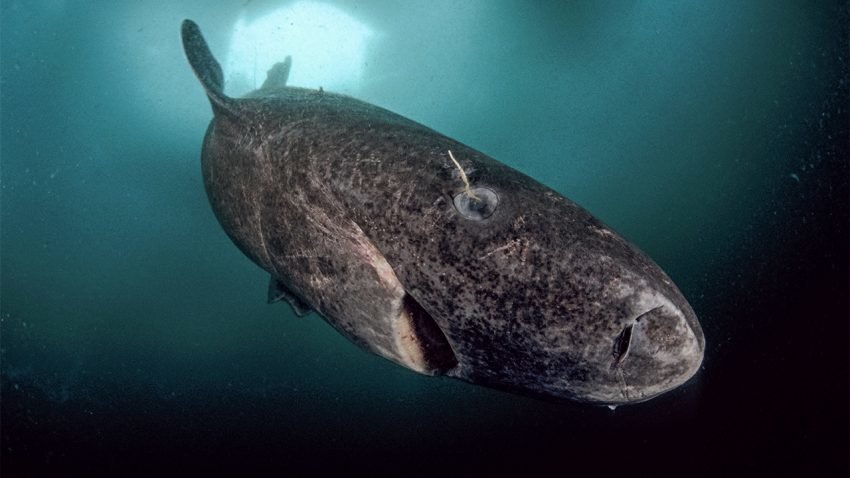
© WaterFrame/Alamy Stock Greenland sharks grow a centimeter a year but live for centuries.
Imagine having to wait a century to have sex. Such is the life of the Greenland shark—a 5-meter-long predator that may live more than 400 years, according to a new study, making it the longest lived vertebrate by at least a century. So it should come as no surprise that the females are not ready to reproduce until after they hit their 156th birthday.
The longevity of these sharks is "astonishing," says Michael Oellermann, a cold-water physiologist at Loligo Systems in Viborg, Denmark, who was not involved with the work. That's particularly true because oceans are quite dangerous places, he notes, where predators, food scarcity, and disease can strike at any time.
Greenland sharks (
Somniosus microcephalus) had been rumored to be long-lived. In the 1930s, a fisheries biologist in Greenland tagged more than 400, only to discover that the sharks grow only about 1 centimeter a year—a sure sign that they're in it for the long haul given how large they get. Yet scientists had been unable to figure out just how many years the sharks last.
Intrigued, marine biologist John Steffensen at the University of Copenhagen collected a piece of backbone from a Greenland shark captured in the North Atlantic, hoping it would have growth rings he could count to age the animal. He found none, so he consulted Jan Heinemeier, an expert in radiocarbon dating at Aarhus University in Denmark. Heinemeier suggested using the shark's eye lenses instead. His aim was not to count growth rings, but instead to measure the various forms of carbon in the lenses, which can give clues to an animal's age.
Then came the hard part. Steffensen and his graduate student Julius Nielsen spent several years collecting dead Greenland sharks, most of them accidently ensnared in trawling nets used to catch other types of fish. After that, they employed an unusual technique: They looked for high amounts of carbon-14, a heavy isotope left behind by nuclear bomb testing in the mid-1950s. Extra carbon from the resulting "bomb pulse" had infiltrated ocean ecosystems by the early 1960s, meaning that inert body parts formed during this time—in particular eye lenses—also have more of the heavy element. Using this technique, the researchers concluded that two of their sharks—both less than 2.2 meters long—were born after the 1960s. One other small shark was born right around 1963.
The team used these well-dated sharks as starting points for a growth curve that could estimate the ages of the other sharks based on their sizes. To do this, they started with the fact that newborn Greenland sharks are 42 centimeters long. They also relied on a technique researchers have long used to calculate the ages of sediments—say in an archaeological dig—based on both their radiocarbon dates and how far below the surface they happen to be. In this case, researchers correlated radiocarbon dates with shark length to calculate the age of their sharks. The oldest was 392 plus or minus 120 years, they report today in
Science. That makes Greenland sharks the longest lived vertebrates on record by a huge margin; the next oldest is the bowhead whale, at 211 years old. And given the size of most pregnant females—close to 4 meters—they are at least 150 years old before they have young, the group estimates.
Oellermann is impressed not only with how old the sharks are, but also how Nielsen and his colleagues figured out their ages. "Who would have expected that nuclear bombs [one day] could help to determine the life span of marine sharks?" he asks.
He and others think cold water helps lengthen the animals' lives by slowing down their growth and biochemical activity. "Lower metabolic rate plays a big role," agrees Shawn Xu, a geneticist at the University of Michigan, Ann Arbor. "But that's not the whole story." Three years ago, his work in nematodes showed that cold can also activate antiaging genes that help an animal better fold proteins, get rid of DNA-damaging molecules, and even fight off infections more effectively, extending life span. The cold-activated molecules "are evolutionarily conserved" across the animal kingdom, and thus these pathways very likely exist in these sharks, too, he predicts.
Paul Butler isn't surprised that frigid waters host such old creatures. In 2013, the sclerochronologist (a scientist who studies the growth of hard tissues in invertebrates) at Bangor University in the United Kingdom and his colleagues described a 500-year-old ocean quahog (
Arctica islandica), a chowder clam found in the North Atlantic. Still, even though two multicentenarian species have turned up in the North Atlantic in just a few years, Butler is skeptical that there are many more out there awaiting discovery. "It won't be that we won't have more surprises," he says, "but I regard these [two] as exceptions."
Could further study offer the following:
Gene-splicing from the shark to humans that could lead to:
- longer lifespans for humans
- better defence against DNA-damaging viruses and 'cancer' mutations
Further understanding of how lowering metabolic rate extends lifespan and sustained stress reduces it - chill out, guys
The importance of reducing exam stress on children and making childhood a time of relaxation and pleasure?